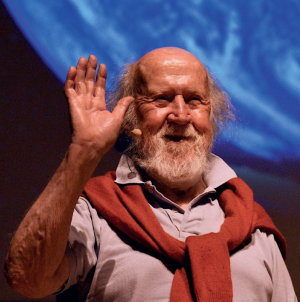Hubert Reeves, a most renowned astrophysicist for both his scientific accomplishments and outstanding outreach efforts, passed away on 13 October 2023.
Hubert Reeves was born in Canada on 13 July 1932 and spent most of his career in France. He was, in my view, the most renowned astrophysicist not only for his contributions in nuclear astrophysics concerning the nucleosynthesis of the chemical elements in space but also for his popularization of science.

Credit: Abaca Press / Alamy Stock Photo
Hubert spent his childhood in a small city named Léry in Quebec, Canada. He graduated from Université de Montréal and obtained a Masters degree in 1955 from McGill University. From 1955 to 1960 he was the graduate student of Ed Salpeter at Cornell University. His PhD thesis is entitled ‘Thermonuclear reactions involving medium light nuclei’ — namely the fusion reactions concerning carbon and oxygen, occurring inside massive stars at the end of their evolution.
From 1960 to 1964, he was a professor of physics at Université de Montréal and also scientific consultant at NASA’s Goddard Institute for Space Physics in New York City. During this period he published a book on nuclear astrophysics entitled ‘Stellar Evolution and Nucleosynthesis’. In 1964, he spent a sabbatical year at l’Université libre de Bruxelles. During that period he was invited to come to France, and was offered the position Directeur de Recherche at CNRS starting in October 1965. I then became his first graduate student. A year later he also became scientific consultant of the Commissariat à l’Energie Atomique et aux Energies Alternatives (CEAE).
During the period 1965–1975, Hubert made two very important scientific discoveries in nuclear astrophysics. These contributions concern the two mysteries left after the 1957 publication of the famous ‘B2FH’ article entitled ‘Synthesis of elements in stars’ by Margaret and Geoffrey Burbidge, William Fowler (who alone received the 1983 Nobel Prize in Physics for this) and Fred Hoyle (Rev. Mod. Phys. 29, 547–650; 1957). These four authors (and also independently Al Cameron) provided a valuable explanation regarding the stellar origin of most of the chemical species listed in the periodic table of elements with the exception of these four: lithium, beryllium and boron (LiBeB) and also deuterium (D), the isotope of hydrogen. Contrary to the other chemical species, LiBeB and D are destroyed and not synthesized inside stars.
Concerning LiBeB, Hubert was struck by the ratio between the LiBeB abundances and those of carbon, nitrogen and oxygen (CNO): it is only one part in one million almost everywhere but becomes as high as 0.25 in the chemical composition of cosmic rays. Hubert engaged his two collaborators of that epoch, namely Maurice Meneguzzi and myself, to analyze quantitatively with him the origin of these three elements induced by the interaction of the Galactic cosmic rays with the interstellar medium. Our model in which we simulate our Galaxy as a porous box for galactic cosmic rays was able to account for the observed abundances of LiBeB (M. Meneguzzi, J. Audouze. and H. Reeves, Astron. Astrophys. 15, 337–359; 1971).
In 1972, Hubert associated himself with Johannes Geiss, who had the very clever idea to request that NASA and the Apollo mission astronauts set up on the lunar surface some simple devices made of thin sheets of aluminium able to trap solar wind particles. From this solar wind composition experiment, Hubert and Geiss were able to determine the cosmic abundance of deuterium, which is synthesized during the first 100 seconds of the Universe and destroyed inside stars. From their determination, we are forced to conclude that there is ten times more invisible matter than nuclear–atomic matter in the Universe. For this important scientific achievement, Geiss and Reeves received the prestigious Einstein Medal in 2001.
Hubert always considered that a scientific process is not complete without popularizing the results. With the help of one of his friends, Jean-Marc Levy-Leblond, he managed to publish in 1982 his first book entitled ‘Patience dans l’azur’ (Patience in the skies), which became a tremendous bestseller internationally. It was followed by more than 30 others, such as ‘L’heure de s’enivrer, l’Univers a-t-il un sens?’ (It is time to get drunk, Is the Universe meaningful?’ or ‘Dernieres nouvelles du cosmos’ (Latest news from the cosmos). Besides his many publications, films, videos, lectures and so forth, Hubert was the main actor of the Festival du Ciel et de l’Espace de Fleurance (Fleurance Sky and Space Festival in Gers, France) since its inception in 1991.
Early this millennium, Hubert Reeves became a very active ecologist to protect our planet for the future of humanity. He was the president of the NGO ‘Humanité et biodiversité’ (Humanity and biodiversity) from 2001 to 2017. Moreover he helped to convince President Jacques Chirac to include the protection of the terrestrial environment in the constitution of the French Republic.
I should write finally that I feel extremely lucky to have been the first graduate student of this exceptional astrophysicist. Hubert was also the thesis advisor of Michel Cassé and Sylvie Vauclair, launching their very bright scientific careers. Thanks to his varied outreach activities, Hubert’s influence on many young scientists was overwhelming. His legacy is enormous. More than many others, he deserves our respect, our admiration and our recognition.
Author information
Authors and Affiliations
Corresponding author
Rights and permissions
Reprints and Permissions
About this article
Cite this article
Audouze, J. Hubert Reeves (1932–2023).
Nat Astron (2023). https://doi.org/10.1038/s41550-023-02156-w
-
Published: 30 November 2023
-
DOI: https://doi.org/10.1038/s41550-023-02156-w
